Jeremiah’s Trunk
Synopsis

Jeremiah’s Trunk is a family-history novel by Denise Tobin Shine, author of the critically acclaimed The Undertakers’ Mother. A multi-generational, heart-warming epic through two centuries, Jeremiah’s Trunk is a well-researched story about the fictional Skinner family. It paints a clear picture of nineteenth century family life on the canals in the English Midlands and of living on the Australian goldfields of Ballarat from the 1850s.
Jeremiah’s Trunk begins in 2013, when we meet a vulnerable young woman living in Melbourne called Abigail Skinner. She’s feeling a little fragile as she’s just buried her mother, Dorothy, and is not particularly interested to discover that she has inherited an old oak trunk from her late Aunt Jane, a stage actress, who died 18 months earlier. Abigail’s much older siblings tell her that the trunk had originally belonged to Jeremiah, a convict ancestor. Hidden under a false floor are three intriguing old journals, written by Abigail’s three times great-grandmother, Leticia.
But it’s the enclosed letter from her late Aunt Jane that turns her world upside down. Abigail is overwhelmed to discover that Jane, her actress mother, gave her up for adoption as a baby, but does not name her biological father.
Still in shock, Abigail turns to Leticia’s journals and discovers what life was like for her ancestors in Britain. Leticia writes of her Dame school, her talented twelve-year-old son, Jeremiah, the local potteries and her friendship with the working narrow boat folk of the canals.
At the dawn of the Industrial Revolution in England and on the eve of the crowning of Queen Victoria, Abigail’s ancestors’ lives are shattered when Jeremiah, now a part-time artist/potter and husband and father, is transported to New South Wales for forgery.
Throughout his convict years, Jeremiah dreams of returning to his homeland, but his life takes a new turn with the discovery of gold in 1851. Jeremiah settles in Ballarat, is deeply involved with the Eureka Rebellion and starts his Australian dynasty.
Meanwhile, Abigail embarks on her own voyage of self-discovery looking for her biological father. She meets friends of her biological mother and explores the historical locations that were part of her ancestors’ era, in Britain and Ballarat. But will she find true happiness?
For a discounted price and prompt delivery of Jeremiah’s Trunk, email Denise Tobin Shine on info@denisetobinshine.com or fill out an Order Form via the website.
Jeremiah’s Trunk is also available for purchase from selected bookshops and online with Amazon, Book Depository and Facebook.
Investigating the ‘stuff’ of Jeremiah’s Trunk
Denise writes:
Jeremiah’s Trunk is written as a dual narrative. Abigail’s story is set in 2013 and the ancestors’ lives come to the page in 1822. For the bulk of the book, I grappled with points of view and the ever-present danger of using anachronisms with both eras. Happily, the final product has given me great satisfaction. It involved years of meticulous research as Jeremiah’s Trunk is set during the Nineteenth century Industrial Revolution of Britain. So, I wanted to ensure that the truth shone through when depicting historical events such as Queen Victoria’s Coronation in 1838 (Chapter 32), the Chartist Riots of 1842 (Chapter 61) and the Eureka Massacre in Ballarat 1854 (Chapter 76).


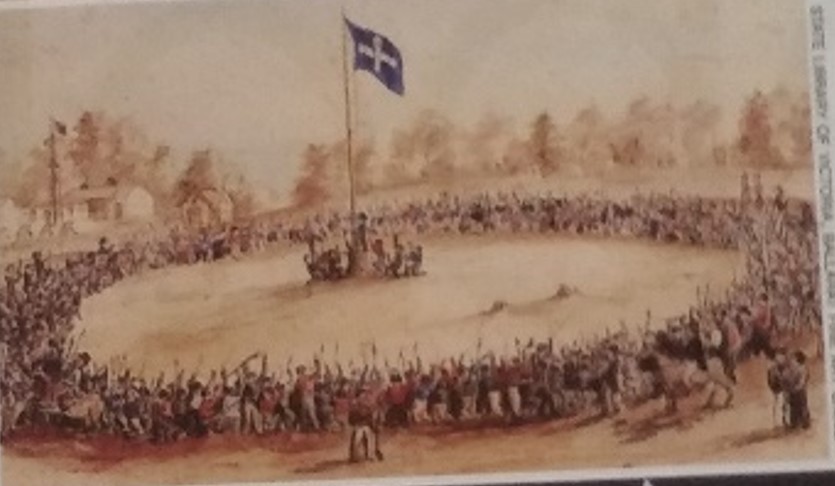

Images above (1) Diggers’ Oath, (2) Burning of Bentley’s Hotel, (3) Eureka Stockade, (4) Eureka Flag
Writers of historical fiction, (Diana Gabaldon – Outlander, Kate Morton – The Forgotten Garden and Edward Rutherfurd – London, Paris, New York,) employ real historical figures and actual historical events to help create storylines. They were a great inspiration for me to play with different time frames and place my characters accordingly.
My husband, Frank and I have cruised the 250-year-old British inland waterways in narrowboats, many times over the past 20 years. When we first tried a week’s cruise on the Midland Canals in 2000, the historical Potteries piqued my interest. Despite the sometimes-contrary lock-gates and stubborn swing bridges, these antique structures intrigued and interested me. Back in Australia, we quickly organised a longer trip for the following year and so began our adventures of cruising hundreds of miles of stunningly scenic countryside, quaint villages and large industrious cities at the average speed of four miles per hour!
After publishing my biographical-fictional The Undertakers’ Mother in 2012, I needed a new plot and characters. With all my first-hand research to call on, I decided to write a fictional yarn using the canals as foundation stones. I consulted web sites and many reference books as listed at the back of Jeremiah’s Trunk. Narrow boat enthusiasts have many a tale to tell, so I included a few snippets of oral information throughout my story.
Abigail in the twenty-first century and Leticia and Meggie in the nineteenth century form a triumvirate of principal female characters. Jeremiah, Leticia’s beloved son, Meggie’s father and Abigail’s convict great-great grandfather, is the central character who links all three women in each century. He tends to be the ‘fall-guy’ in the tale. Although a talented artist from a respectable pottery family, he’s often in the wrong place at the wrong time. Despite his shortcomings, we want him to triumph in the end.
Being an advocate of family-history, I wanted a contemporary character as my principal protagonist and like the historical events, the present-day occurrences needed legitimacy. Hence Abby’s arrival in London in 2013 coincides with the birth of Prince George, followed by the frightening wide-spread electrical storm that ends the heatwave at 4 am the next morning. See Chapters 38 &39.
[Frank and I were moored in a canal boat that night and were awakened by a deafening bolt of lightning that felled a nearby tree. For a few frightening moments, we thought the lightning had hit our boat!]
Of course, Abigail has her hands full with her hunt for her biological father. So, it was truly enjoyable and a real education to visit nearly every museum and location in both England and Australia, that she visits in the book. As most of my research was conducted after 2013, I was constantly challenged by changes that may have occurred since Abigail’s time.
When one intends to write the truth, it’s important to research carefully so that the truth shines through – even in a work of fiction!
The images represent a tiny fraction of the research that inspired me when bringing the Industrial Revolution to the page. They also highlight eighteenth and nineteenth century engineering skills showing some locks, tunnels, bridges and a spectacularly famous aqueduct plus horse-boats and people of the period in my book. Most of these images find their way into various scenes in Jeremiah’s Trunk.





Images above:-
(1) Etruria Junction – 2013
(2), (3) & (4) Gladstone Pottery AKA Sargood Pottery Hanley (chapter 8)
(5) Saggar stacks in bottle oven


Images above:-
(1) Bedford Street Locks (Lower)
(2) Upper Lock – Chapters 16-18



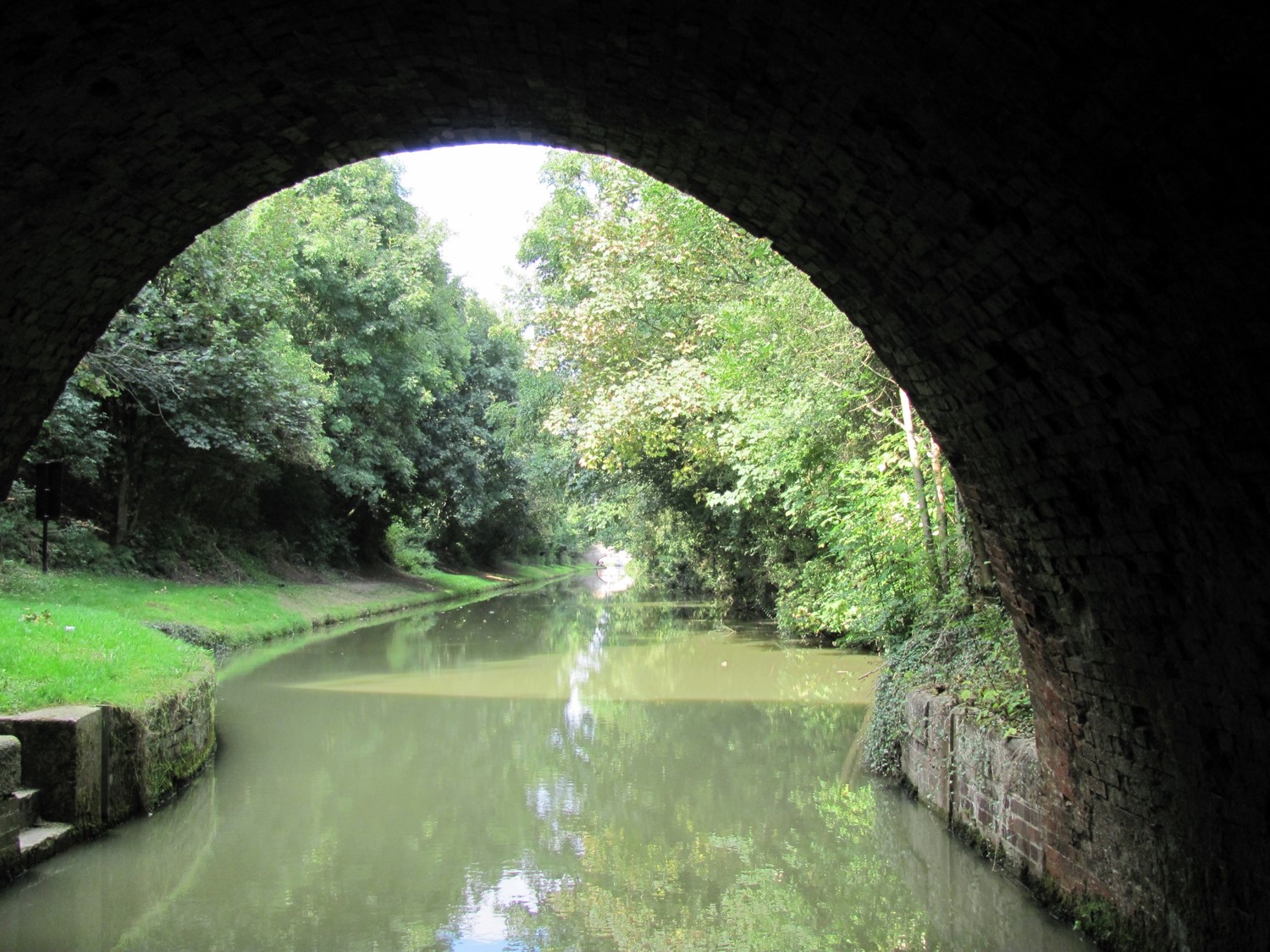

Images above:-
(1) Disused Brindley Tunnel at Harecastle Hill
(2) Telford built Harecastle Tunnel -old Brindley tunnel at right – Chapters 6 and 16
(3) Denise at Blisworth Tunnel portal – chapter 26
(4) Inside tunnel portal
(5) Crossing Chirk aqueduct – Llangollen Canal



Images above:-
(1) Roving bridge – takes towpath to other side of the canal.
(2) Cast iron roving bridge Hawksbury Junction – Chapter 26
(3) Ornate towpath bridge Braunston Marina – Braunston chapters 19 & 26


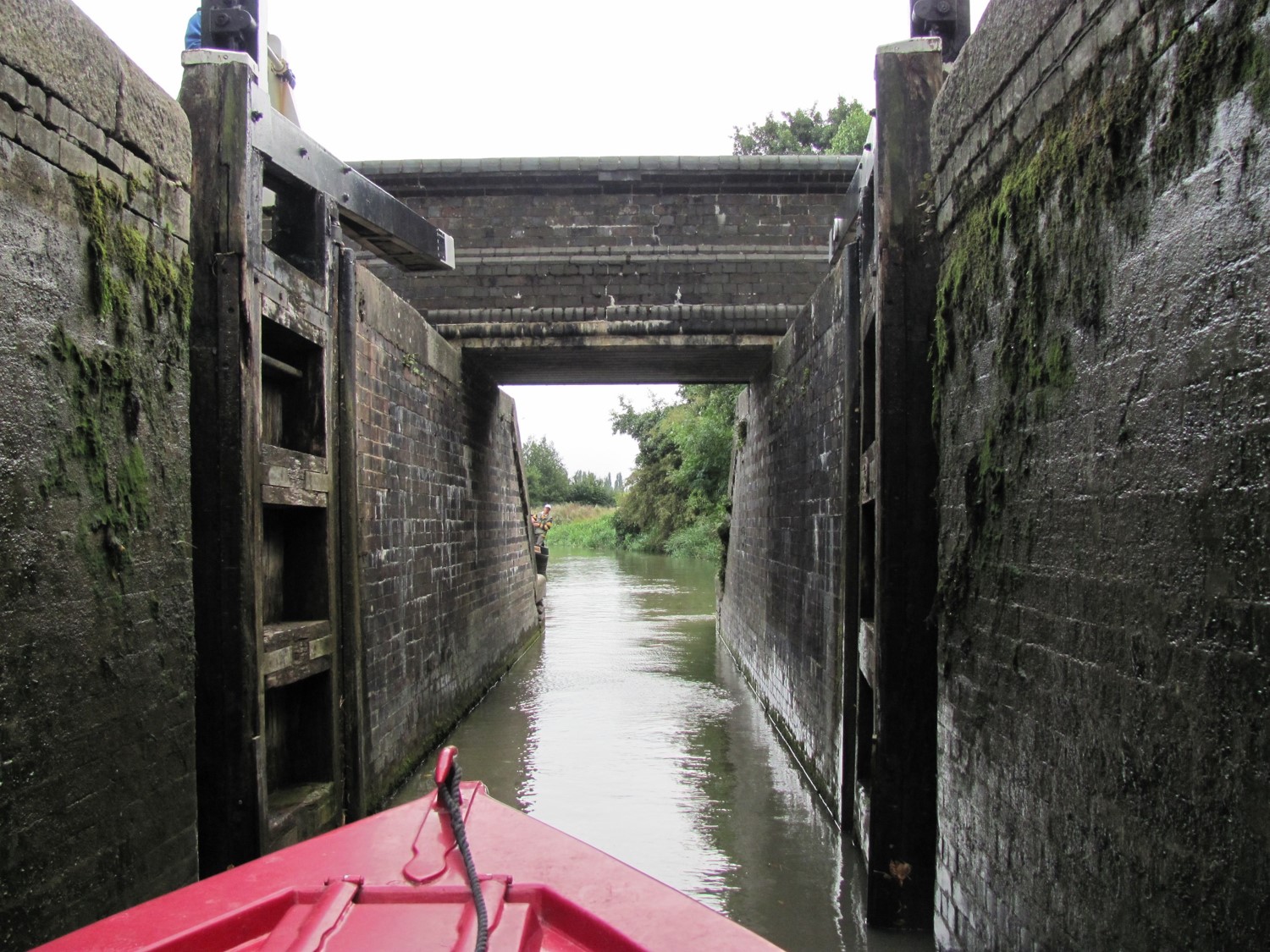


Images above:-
(1) Bottom of Bingley Five Rise – Leeds and Liverpool Canal
(2) Descending Bingley Five
(3) Exiting a Watford Lock –GU Leicester canal
(4) Preparing to moor on River Nene
(5) Top of Bingley Three Rise




Images above:-
(1) Narrow boat horse and child-leader sculpture
(2) Crocheted horse cap protected the horse’s ears from flies – Chapter 6
(3) Working horse with feeder, towing boat
(4) Traditional boats ascending Foxton staircase locks
In the first half of the book, Leticia and Jeremiah take the central roles in the story, leaving Abigail to pop up regularly in 2013, to remind us of her own issues. Also, with the use of modern technology, she could add extra flavour to the happenings in her ancestors’ lives. Abigail’s own story leads the second half of the book. We follow the ancestors’ highs and lows, as the journals record their family lives of deaths, marriages and births. They labour as painters, teachers and potters, while many secondary characters support various dramatic plot-lines including run-ins with the law. Famous figures like the potter Josiah Wedgwood, the artist John Constable and the Immigrants’ Friend, Caroline Chisholm feature quite prominently in their own time in history. Later in the book, we read how Jeremiah and his family intermingle with the gallant heroes of Ballarat’s Eureka Stockade including appearances by Peter Lalor, J.B. Huffray and S.T. Gill.


Images above:-
(1) & (2) John Alloo’s Chinese Restaurant 1855 – by S.T.Gill (Chapter 74)
Although Jeremiah’s Trunk is a work of fiction, there is no excuse for writing errors when recording well-known facts. There were many families trying to eke out a living by 1854 in Ballarat, therefore, I worked hard to make my fictional Skinner family shine a light on what life was like for all families at such a momentous time in our country’s history. About 80% of my research didn’t make it into the final publication. But it still needed to be done in case a few hidden morsels or literary gold nuggets jumped out at me.
After about two years of inhabiting the nineteenth century through Leticia’s journals, I took up Abigail’s story seriously. While lurking in the nether regions of my mind, I’d wondered what to do with her. By my reckoning, after opening the trunk, Abigail would need a personal ‘pay-off’. But I had no idea what could ‘be-in-it’ for her! An inheritance . . .? If so . . . what . . .? A grand pile somewhere? – Mansion or money? A gold-mine? – I didn’t have a clue!
Although I jot down notes about dates and historical happenings, until I’m in the heads of my characters, even I don’t know what’s going to happen. So, when Abigail’s Aunt Jane takes control in Chapter Two and leaves a letter for Abigail admitting that she was her birth mother and she gave her up for adoption to Edward, her now long-deceased brother and his wife, Dorothy, I too got a shock! Many authors speak of ‘light-bulb’ moments and Jane definitely created such a moment for me. In this case, Jane took over from me and my dilemma re a ‘pay-off’ for Abigail was solved! Her story now had a strong foundation to build on and she had a cause – to find her biological father – dead or alive!
And Abigail’s personal pay-off? Please read the book and discover for yourself!
Plot prompts and props
Fiction writers are always looking for inspiration to keep their readers engaged in their stories. As my historical-fiction reading is so holistic, I often feel intrigued by a particular idea that serves as a ‘prompt’ in my own writing. But one needs to beware of plagiarising other authors’ work. So, inventing my own ‘props’ was challenging, but exciting.
Josiah Wedgwood’s ‘Slave’ Medallion
Leticia mentions Wedgwood’s Medallions to Jeremiah in Chapter Five of Jeremiah’s Trunk. While I was writing the book, I visited the National Gallery of Victoria several times – usually to check out John Constable’s Lock painting which features prominently in the story.

Image courtesy of National Gallery of Victoria
About 12 months before I published the book, I was nearly blown away to see in a special glass case, one of Wedgwood’s medallions! I could hardly believe my eyes. These extremely rare medallions were made by Wedgwood around 1787 for distribution to advocates for the abolition of slavery. ![]() The cameo medallion showed a kneeling slave, manacled and
The cameo medallion showed a kneeling slave, manacled and ![]() begging with the embossed inscription ‘Am I not a Man and a Brother?’ Both men and women wore them to publicise the campaign and signal their support for the abolitionist cause.
begging with the embossed inscription ‘Am I not a Man and a Brother?’ Both men and women wore them to publicise the campaign and signal their support for the abolitionist cause.
The gallery was given the medallion by the Wedgwood Society of Australia in 2017, so I couldn’t include it in Abby’s time-frame of 2013. But it was the notation that stated that Wedgwood had given the medallions away that made me hurry home to edit what I’d written. I’d presumed he’d sold them.
Canaliaware
One of my readers of an early draft, ‘googled’ Canaliaware and much to his surprise he couldn’t find it! Of course, I was delighted that he thought such a product had existed in the Potteries of the nineteenth century. My invention was authentic!
During his time of working in the family pottery, Jeremiah designs porcelain images called Canaliaware which is well-described in Chapter 14. If so inclined, you can google ‘Canaliaware’ where Amazon quotes a sentence from the five- star eBook version of Jeremiah’s Trunk! So, my early reader’s efforts were not senseless – just ahead of the book’s publication!




Images above:-
(All) Staffordshire ornaments made for the mass market (Chapter 14)
Narrow Boat Teapot
Carter’s Teapot Company have been making character teapots for many years. Among their numerous and varied designs are two sizes of narrow boat-shaped teapots. I first saw a narrow boat teapot at the home of my friends, who make a cameo appearance in Chapter 48 of Jeremiah’s Trunk; and I knew I had to include it in my story. It became an important prop. See Chapter 53
I am now the proud owner of a narrow boat teapot!

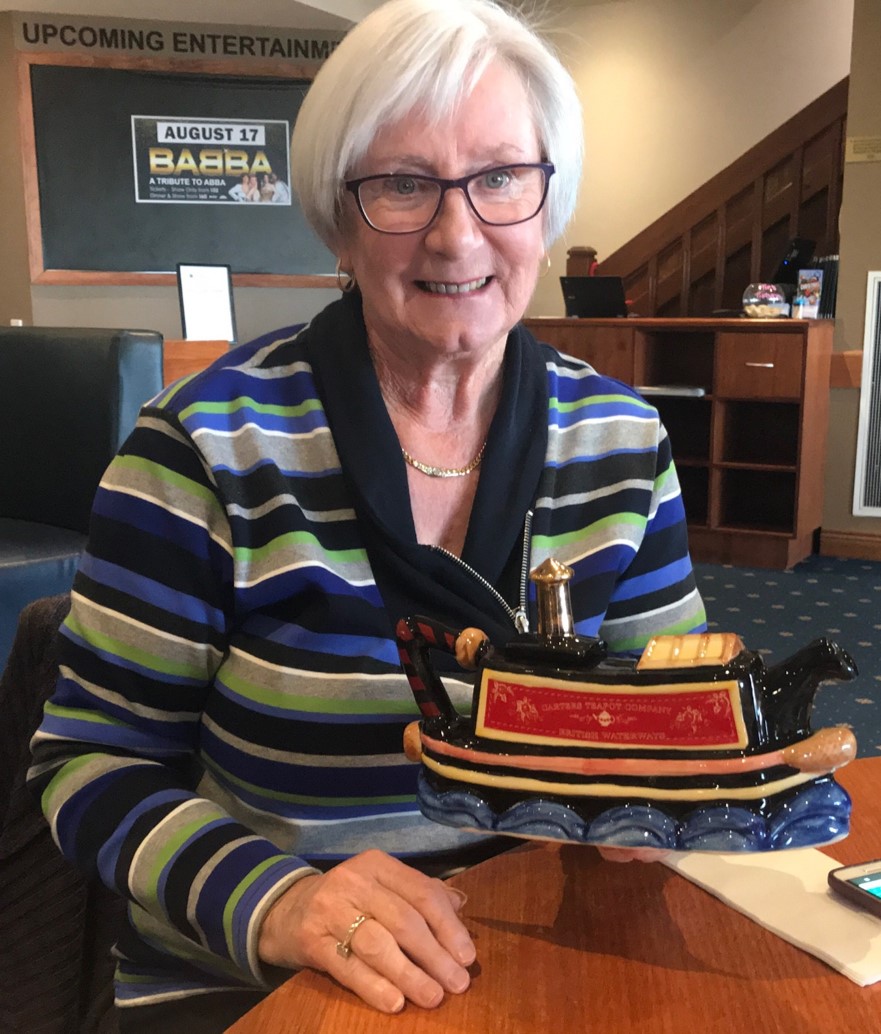
Images above:-
(1) Narrow-boat teapot
(2) Author with her own tea-pot
Little- known Facts
Over the years, I’ve heard several well-known historical novelists speak of the quiver of excitement they feel when a little- known fact or object suddenly crosses their paths. Often quirky or cloistered in local folklore, such a discovery can allow a writer to expand it into an attention-grabbing story-line. With the freedom of writing fiction, I made use of such ploys on a few occasions.
- Roses and Castles is a style of art used to decorate narrow boats and accessories that probably originated in the 1850s. In the book, Jeremiah started painting the decorations ten years earlier! A number of theories as to the origins of the paintings exist, but no one has been identified as the creator of the colourful tradition. See Chapter 21


Images above:-
(1) cabin interior of traditional narrow boat
(2) Lidded-stool painted with roses and castles
- Mac, the Pike-man’s Dog features in a special memorial at the Eureka Stockade Memorial Park Ballarat. I researched the story of Mac, the pikeman’s dog and being unable to discover his fate, I got Jeremiah, always a doggy-man, to bring the little emaciated dog home from the cemetery, to be cared for the rest of his life. See Chapter 76.
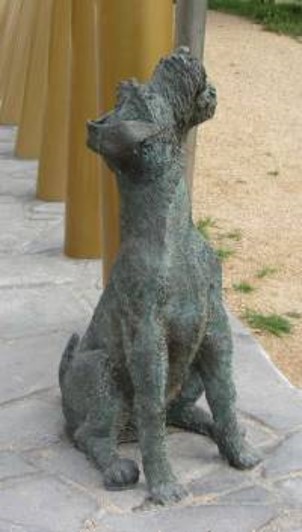

Images above:-
(1) Mac The Pikeman’s Dog – Eureka Memorial
(2) Launching the Eureka Memorial